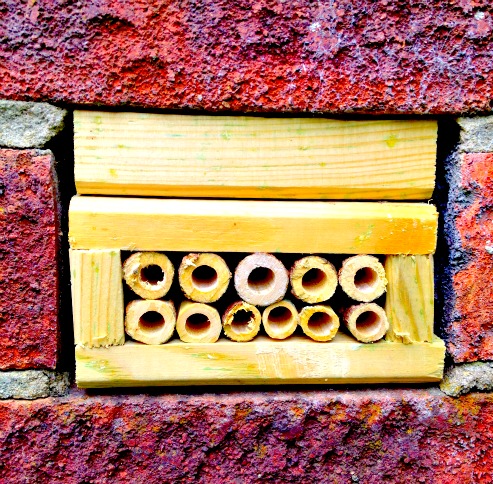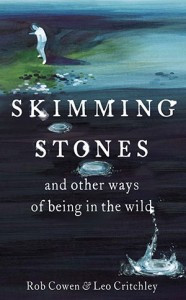Miss Thrifty1 May 18, 2012

I love working opposite Rob, aka Harrogate’s very own Wild Man of the Woods. In he bounds, first thing on Monday morning, to tell me about his latest adventures. A couple of weeks ago, he found a stash of wild garlic growing on the riverbank a couple of miles from our office. Last weekend, he built a house in his back garden for ladybirds, to encourage them to come and eat all the greenfly. I get to say, “Come on then – write me a post!” And he does, because he’s nice like that. So here is Rob’s guide to building a garden bughouse…
You don’t need acres of sweeping lawn to be green fingered and get more nature into your life. Even the most humble backyard can be converted into somewhere that brings the bees, butterflies and ladybirds closer to our kitchen doors. All it takes is the odd pot or two, some soil and a few flowers and you have the makings of an entire ecosystem. However, like any good dinner party, you want to ensure the right kinds of guests in your garden and there’s no better way to attract A-list species than laying on some five-star accommodation.
After the lashing suffered by the UK in recent weeks, it was a joy to walk into my own little patch of ground this weekend and find it awash with bright sunlight. Unfortunately it was also awash with something else: greenfly. The wild rose that grows in great, twisting curls around our trellis (and serves as a picturesque barbwire on an outside wall) was coated with an impressive amount of little green larvae. They were stuck on the buds and leaves like corn on the cob and while dormant now, the thought of picking great clouds of the critters out of my hard-earned sundowners over the next few weeks was pretty unappealing. Not to mention the damage they would do to my Titchmarsh-esque toil over the last few weeks.
Many websites will tell you that virulent chemical sprays and bug killers are the only answer but, as ever, nature has a perfectly safe and sustainable solution that costs nothing and doesn’t damage the earth. Aphids, such as greenfly, are irresistible to ladybirds so after a quick trip to our patch of common ground with an empty cappuccino cup and lid, I returned with twenty new residents: the lovely, native seven-spot variety.

As they got to work on the free dinner, the only issue that remained was beds. Ladybirds hibernate over winter and are more likely to think about hanging around if suitable shelter is provided. Building your own bughouse will attract other hibernating insects that are great for any garden too: graceful lacewings, butterflies and bees. They all like tunnels that can keep them safe and dry, away from birds, wind and wet weather as they doze through the winter.
Don’t bother with expensive bughouses from garden centres; there is joy to be had in making your own and you will feel a greater sense of satisfaction when new friends populate your handiwork. All you need is to find a patch of elder. If you’re not acquainted with this most generous shrubby tree, then it’s high time to re-tune your thrifty antennae anyway. Elder provides flowers in early summer that make a fantastic cordial, or can be dried, stored in airtight jars and spooned into hot water for a relaxing bedtime tea. In autumn the berries make a fantastic, thick, deep red jam or syrup that has powerful antiviral and antioxidant qualities and purifies the blood.
Elder is also extremely common and easy to identify. Look around any roadside verges, parks, woods, field boundaries, wastelands and railway lines for a bush-like, shrubby tree. It has oval-shaped, serrated leaves that grow in opposite pairs and a cracked, corky bark grey-brown in colour. The telltale squashy removable pith, which historically made it such an ideal musical instrument-making material, runs through its core.
Saw off a branch or two that is about the width of your index finger and cut into sections about ten centimeters long. Use a screwdriver (or drill bit if you’re in a rush) and hollow out the pith in the middle until you have lots of lengths of hollowed out tubes. Next find some old wood (I used an old off-cut of trellis at the back of my little shed), cut it and nail together to make a simple rectangular frame. Simply glue the inside of the frame and lay the tubes in rows until you fill the space. If it is getting to be a tight fit, shave off some of the elder tubes’ outer layer with a penknife until they all fit snugly.
Site the bughouse near your ladybirds in a shelter spot. In my case, I have a hole in a brick wall that provided the perfect gap and I built the house to fit inside it. Others paint them with their children and hang them from trees, or place them on the ground, tucked under shrubs or bushes.
By the time I had finished making mine, the sun was dropping behind the pitched roofs and chimney pots. I pulled on a thick jumper and sat with a cup of tea admiring my handiwork. Suddenly, into the yard drifted an orange-tip butterfly. It was the first I had seen in many years and I had to get up and approach slowly to make sure it wasn’t just a petal of blossom caught in the rising evening breeze. But there it was, basking in the last light on the forget-me-nots, flicking its wings slowly, casing out its new home for the colder months. Nearby, two ladybirds were enjoying the sunset, sharing a tender moment in the chives. As seals of approval go, you can’t get much better.
 Rob Cowen is co-author of Skimming Stones and other ways of being in the wild (Hodder) with Leo Critchley. They were recently described by the Guardian as “two of the UK’s most exciting nature writers” and appeared on BBC 2’s The Culture Show and as guests on BBC Radio 2. For more great ideas about getting close to nature, read their book and visit their blog.
Rob Cowen is co-author of Skimming Stones and other ways of being in the wild (Hodder) with Leo Critchley. They were recently described by the Guardian as “two of the UK’s most exciting nature writers” and appeared on BBC 2’s The Culture Show and as guests on BBC Radio 2. For more great ideas about getting close to nature, read their book and visit their blog.
1 Response to “Nurture nature in your garden: build a bughouse”